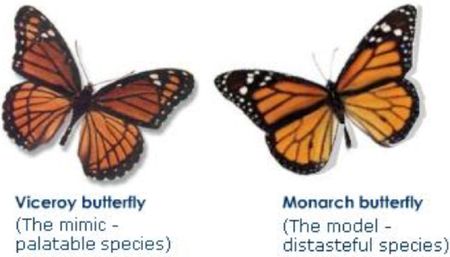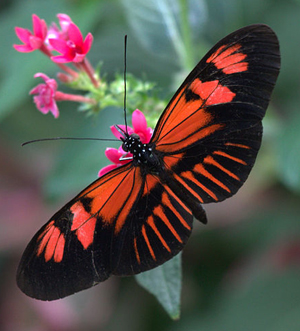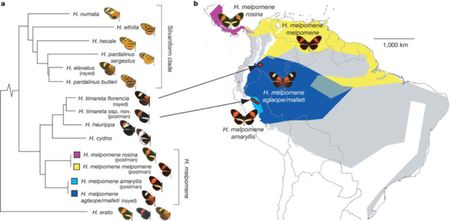[author: Kevin E. Noonan]
Mimicry is a classic (and classical) biological phenomenon, the appreciation of which dates to the time when biology was more accurately called "natural history" and was more diversion for English country gentlemen than proper science. Perhaps the most well-known form of mimicry is Müllerian mimicry, and the best example of that is the viceroy butterfly (Limenitis archippus), which although tasty to avian predators displays markings almost indistiguishable from the monarch butterfly (Danaus plexippus), which is not only unpalatable but actually toxic to birds (see below). Anyone with even a rudimentary appreciation of Linnean classification will recognize another interesting feature of mimicry: despite their visual similarities, the monarch and viceroy butterflies are not only different species but members of different genera, suggesting that genetic inheritance cannot account for the convergence in wing pattern phenotype.

 Recent work employing genomic sequencing and linkage analysis (from the Heliconius Genome Project) has begun to shed light on the genetic bases for Müllerian mimicry. This work was performed on a South American butterfly species, Heliconius melpomene (at right). As reported in Nature (doi:10.1038/nature11041), naturally occurring species of Heliconius show significant introgression in regions related to color pattern development. Heliconius butterflies comprise 43 species and hundreds of races and make up rapidly radiating butterfly species in South America; certain of these species exhibit classic Müllerian mimicry, wherein palatable species adopt the color pattern of other species that are unpalatable to bird predators. The authors sequenced almost 13,000 genes (12,669 open reading frames) in the 269 megabase (Mb) butterfly genomic DNA and mapped the majority (~83%) of these genes to the 21 Heliconius chromosomes using a modern version of RFLP analysis termed restriction site DNA linkage mapping. This work found that the chromosomal organization of Heliconius butterfly genomic DNA was "broadly conserved" since the evolutionary split from a common ancestor shared with Bombyx (silkmoth) species in the Cretaceous (~100 million years ago). Comparison with the Bombyx mori (silkmoth) genome identified 6,010 orthologues and previously unidentified chromosomal fusions in the Heliconius chromosomal complement. Biologically important expansion was found in families of genes related to chemosensation and body shape and form (homeobox, or Hox, genes). The Heliconius genome showed an expected increase in ultraviolet opsins (due to the diurnal lifestyle adopted by butterflies) and an unexpected genetic complexity in olfactory genes (33 Heliconius olfaction genes, similar to what was found in monarch butterfly species having 34 olfactory genes). The researchers also found additional Hox genes related to body shape and form, similar to what is found in other butterflies and related dipteran species.
Recent work employing genomic sequencing and linkage analysis (from the Heliconius Genome Project) has begun to shed light on the genetic bases for Müllerian mimicry. This work was performed on a South American butterfly species, Heliconius melpomene (at right). As reported in Nature (doi:10.1038/nature11041), naturally occurring species of Heliconius show significant introgression in regions related to color pattern development. Heliconius butterflies comprise 43 species and hundreds of races and make up rapidly radiating butterfly species in South America; certain of these species exhibit classic Müllerian mimicry, wherein palatable species adopt the color pattern of other species that are unpalatable to bird predators. The authors sequenced almost 13,000 genes (12,669 open reading frames) in the 269 megabase (Mb) butterfly genomic DNA and mapped the majority (~83%) of these genes to the 21 Heliconius chromosomes using a modern version of RFLP analysis termed restriction site DNA linkage mapping. This work found that the chromosomal organization of Heliconius butterfly genomic DNA was "broadly conserved" since the evolutionary split from a common ancestor shared with Bombyx (silkmoth) species in the Cretaceous (~100 million years ago). Comparison with the Bombyx mori (silkmoth) genome identified 6,010 orthologues and previously unidentified chromosomal fusions in the Heliconius chromosomal complement. Biologically important expansion was found in families of genes related to chemosensation and body shape and form (homeobox, or Hox, genes). The Heliconius genome showed an expected increase in ultraviolet opsins (due to the diurnal lifestyle adopted by butterflies) and an unexpected genetic complexity in olfactory genes (33 Heliconius olfaction genes, similar to what was found in monarch butterfly species having 34 olfactory genes). The researchers also found additional Hox genes related to body shape and form, similar to what is found in other butterflies and related dipteran species.
The researchers compared genomic DNA from three co-mimicry species, Heliconius melpomene, Heliconius timareta, and Heliconius elevatus and produced a genetic tree between 84 individuals from H. melpomene and related species (see below). In this comparison, the researchers found hybrid exchange especially at two genomic regions that control mimicry pattern based on ~4% (12Mb) of the genome. The results obtained from Heliconius melpomene amaryllis and H. timareta ssp. were compared and the researchers report evidence of greater hybrid interbreeding between these species when compared with H. melpomene aglaope and H. timareta ssp, which do not have overlapping spatial ranges. The researchers estimated 2-5% exchange of the genome; the introgression was not uniformly distributed over the 21 chromosomes but seems to be limited to 11 chromosomes with two chromosomes showing the strongest frequency of introgression. These regions, comprising loci known to be associated with red pattern (B/D) and yellow (N/Yb) pattern loci, showed blocks of sequence (~100 kb in size) are shared between species was exchanged in hybrids. The genetic makeup of these shared blocks of sequence were more consistent with hybrid introgression (and fixation) than in other alternatives, such as convergent evolution.

The researchers concluded that these species exchange protective color pattern genes promiscuously and that their evidence of hybrid exchange and fixation indicates that this mode of gene transfer between diverse species may be a more important mechanism for explaining phenomena like mimicry than had been previously appreciated. The authors propose that hybridization between mimicking species is a plausible explanation for "parallel evolution of multiple mimetic patterns" in these species.
Supplemental experimental details can be found here.
Image of Heliconius melpomene by Greg Hume, from the Wikipedia Commons under the Creative Commons Attribution-ShareAlike 3.0 Unported license.